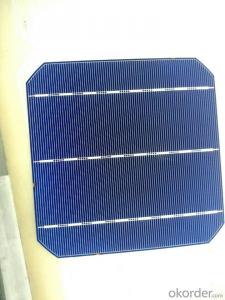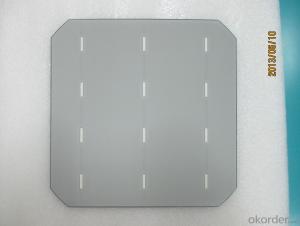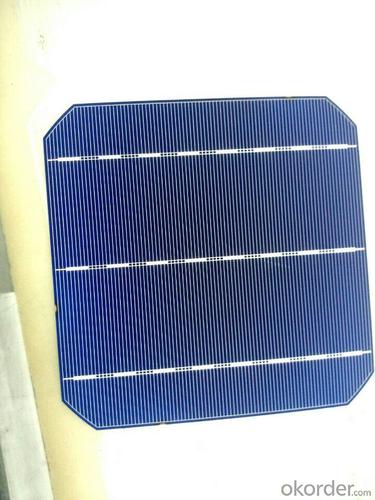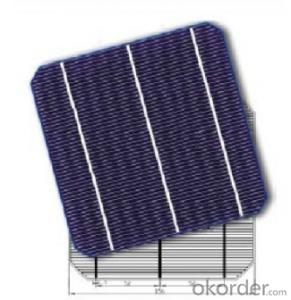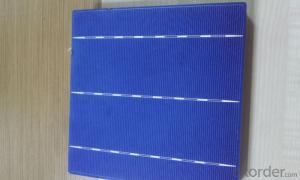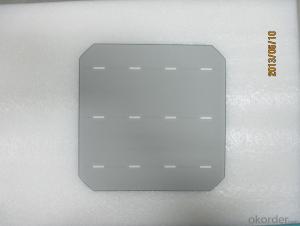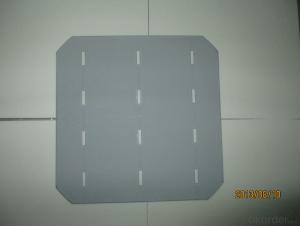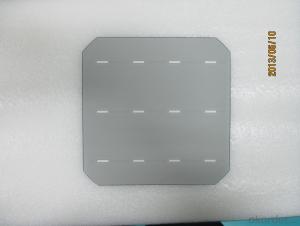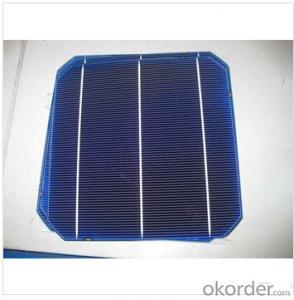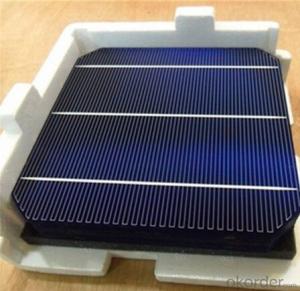Solar Cells 6x6 Mono 156*156mm Monocrystal Solar Cell with 4.67 Watt High Efficiency
- Loading Port:
- Shanghai
- Payment Terms:
- TT or LC
- Min Order Qty:
- 1000 pc
- Supply Capability:
- 20000000 pc/month
OKorder Service Pledge
OKorder Financial Service
You Might Also Like
Brief Introduction of Solar Cells
A solar cell, is an electrical device that converts the energy of light directly into electricity by the photovoltaic effect, which is a physical and chemical phenomenon. It is a form of photoelectric cell, defined as a device whose electrical characteristics, such as current, voltage, or resistance, vary when exposed to light. Solar cells are the building blocks of photovoltaic modules, otherwise known as solar panels
Monocrystal solar energy cell
Type:156M
Appearance:156×1565㎜±0.5mm; Diagonal:R=100mm
Main fence wide:1.4-1.5mm Back electrode wide:2-2.5mm
Fence line qty:90
Cell thickness:220um±20um
Eff(%) | 19.1- 19.2 | |||||||||||
Pm(W) | 4.56 | |||||||||||
Isc(A) | 8.93 | |||||||||||
Im(A) | 8.51 | |||||||||||
Voc(V) | 0.64 | |||||||||||
Vm(V) | 0.538 | |||||||||||
FF(%) | 80 |

remark:our company cells as per working current concentrate principle,separate the first and the second grade
Applications of Polycrystalline Solar Cells
Assemblies of photovoltaic cells are used to make solar modules which generate electrical power from sunlight, as distinguished from a "solar module" or "solar panel". A solar array generates solar power using solar energy.
Factory Picture of Solar Cells
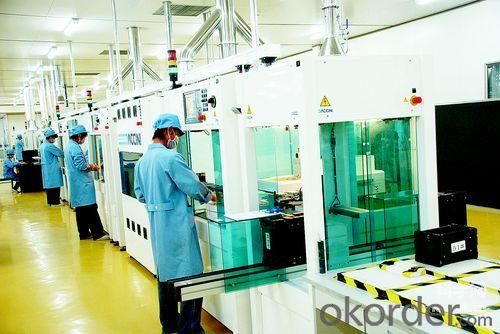
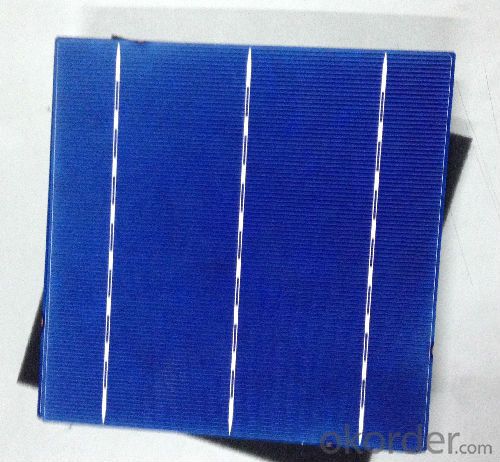
FAQ
We have organized several common questions for our clients,may help you sincerely:
What’s price per watt?
A: It’s depends on the quantity, delivery date and payment terms of the order. We can talk further about the detail price issue. Our products is high quality with lower price level.
Can you tell me the parameter of your solar cells?
We have different series of cells with different power output, both from c-si to a-si. Please take our specification sheet for your reference.
How do you pack your products?
We have rich experience on how to pack the panels to make sure the safety on shipment when it arrives at the destination.
Can you do OEM for us?
Yes, we can.
How long can we receive the product after purchase?
In the purchase of product within three working days, We will arrange the factory delivery as soon as possible. The perfect time of receiving is related to the state and position of customers. Commonly 7 to 10 working days can be served
How Much Do Solar Panels Cost On My Roof?
When you ask, “How much do solar panels cost?,” what I think you really want to know is how much it costs to put solar panels on your roof, right?
The bulk of the price of going solar is now the “soft costs” (installation, permitting, etc.) rather than the solar panel cost. Referencing the latest US Solar Market Insight report, the average installed cost of a residential solar panel system is approximately $3.50/watt. (For commercial rooftops, it’s approximately $2.00/watt.)
However, prices vary tremendously by region. “Common residential system prices ranged from less than $3.00/W to just above $7.00/W,” the Solar Energy Industries Association wrote in 2014 regarding 2013 figures. The story hasn’t changed much since then, even though prices on both ends have come down.
The total price of a system, of course, varies tremendously based on the size of your roof and your electricity needs as well.
So, the key is really just to get an initial quote and then get a closer look at your situation from a local installer, who can give you a more specific quote.
Decrease the cost of solar cells
Reduce the silicon material production cost will be the most important measure. At present, under the condition of the high price of silicon, silicon material accounted for 70% ~ 80% of the cost, it is the reason about that. Control the cost of the battery production, Reduce consumption equals reduce cost, silicon material shortage bring a deadly blow to the industry, at the same time, also promote technological progress. Thinned wafers is a very important measure for any country to reduce cost or to improve the efficiency. Then, improve the efficiency of the battery .However, the speed of Battery efficiency increases depend on the quality of process equipment, pursuit of efficiency will make the cost increase a lot. As a business perspective, improve the efficiency of battery and cost of equipment should maintain a balance.
Develops equipment potential will be the another choice. We should vigorously carry out technological innovation, develop the high effectively ways on reduce the cost and improve the conversion efficiency of new technology, new material. At the same time we should pay attention to the integration technologies, the development of large-scale production line, to make solar cells more competitive.
- Q: What is the role of grounding systems in solar cell systems?
- The role of grounding systems in solar cell systems is to provide a safe and efficient pathway for the dissipation of electrical faults and to protect the system from electrical surges and lightning strikes. Grounding systems help minimize the risk of electrical shock, equipment damage, and fire hazards by establishing a connection to the earth, allowing excess electrical energy to be safely redirected and dispersed.
- Q: What is the role of solar cells in powering traffic signals?
- Solar cells play a crucial role in powering traffic signals by harnessing sunlight and converting it into electrical energy. This renewable energy source eliminates the need for traditional grid connection and reduces the environmental impact of traffic signals. Solar cells ensure a sustainable and reliable power supply for traffic signals, even during power outages, while simultaneously reducing energy costs and promoting a greener transportation infrastructure.
- Q: Can solar cells be used in areas with high pollution?
- Yes, solar cells can be used in areas with high pollution. While pollution can reduce the efficiency of solar cells, they can still generate electricity in such areas. However, regular cleaning and maintenance may be required to ensure optimal performance.
- Q: How do solar cells perform in urban environments?
- Solar cells can perform well in urban environments, although their efficiency may be slightly reduced compared to more ideal conditions. The presence of tall buildings and shadows can partially block sunlight, affecting the overall energy output. However, advancements in solar technology, such as the use of bifacial panels and improved tracking systems, can help mitigate these challenges by capturing light from multiple angles and adapting to changing conditions. Moreover, the increasing installation of solar panels on rooftops, facades, and other urban structures is significantly contributing to the adoption of renewable energy in cities.
- Q: Can solar cells be used in shopping centers?
- Yes, solar cells can be used in shopping centers. They can be installed on rooftops or in parking lots to generate clean and renewable energy, helping to reduce electricity costs and carbon emissions. Solar cells can also be integrated into the design of buildings, such as glass facades or awnings, allowing shopping centers to harness solar power while maintaining aesthetic appeal.
- Q: What is the impact of dust storms on solar cell efficiency?
- Dust storms can significantly reduce solar cell efficiency by blocking sunlight and accumulating dust particles on the surface of the cells. The dust particles act as a barrier, preventing sunlight from reaching the cells and reducing their ability to generate electricity. This can lead to a decrease in power output and overall efficiency of the solar panels. It is essential to regularly clean and maintain the solar panels to mitigate the negative impact of dust storms and ensure optimal performance.
- Q: My son is very interested in solar cells recently, and keeps asking me about the structure of a solar cell. Can anybody help me answer that question?
- As a newly-developed power generation technology, solar cells are considered to be an evironmental-protecting green energy
- Q: How do solar cells handle power quality issues?
- Solar cells do not directly handle power quality issues. However, inverters, which are an integral part of solar power systems, help mitigate power quality issues. Inverters convert the direct current (DC) produced by solar cells into alternating current (AC) that is suitable for use in electrical systems. Modern inverters include features such as voltage regulation, frequency control, and power factor correction, which help maintain power quality within acceptable limits. Additionally, grid-tied solar systems often rely on the electrical grid to balance power quality issues, as excess solar electricity can be fed back into the grid or drawn from it when needed.
- Q: How does the size of a solar cell affect its performance?
- The size of a solar cell directly affects its performance. Larger solar cells have a higher surface area, allowing them to capture more sunlight and generate more electricity. This results in a higher power output and overall performance compared to smaller solar cells.
- Q: How do solar cells handle lightning strikes or electrical surges?
- Solar cells are designed to handle lightning strikes or electrical surges by incorporating protective mechanisms. This includes surge protectors, lightning arresters, and grounding systems. These components divert the excessive electrical energy away from the solar cells, preventing damage to the cells and other connected devices.
Send your message to us
Solar Cells 6x6 Mono 156*156mm Monocrystal Solar Cell with 4.67 Watt High Efficiency
- Loading Port:
- Shanghai
- Payment Terms:
- TT or LC
- Min Order Qty:
- 1000 pc
- Supply Capability:
- 20000000 pc/month
OKorder Service Pledge
OKorder Financial Service
Similar products
Hot products
Hot Searches
Related keywords
